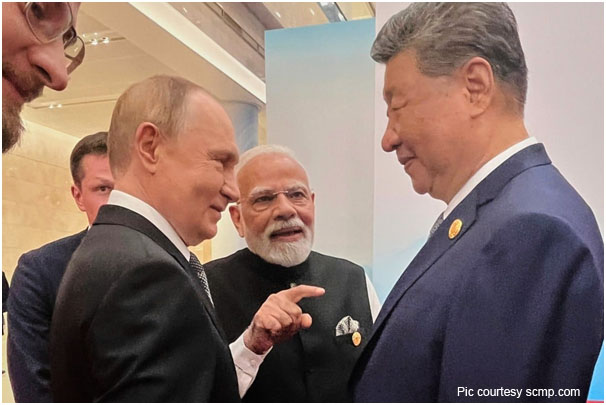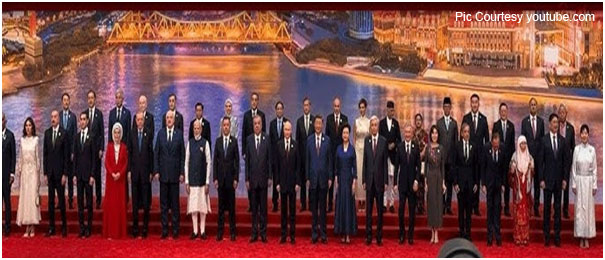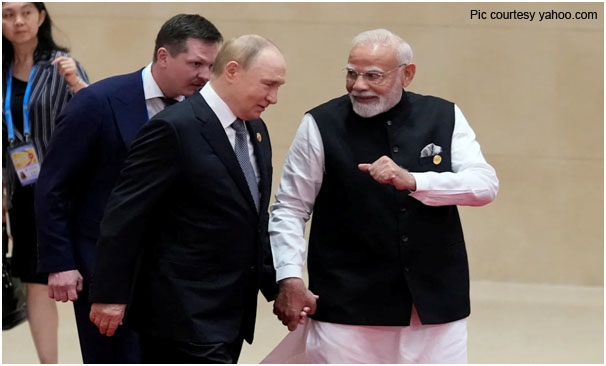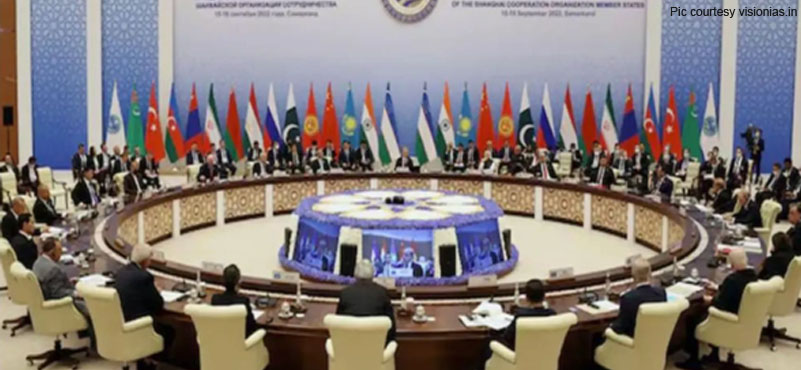Diplomacy in the present geopolitical flux is neither a straight line nor a binary choice. It is layered, uncertain and often contradictory. In the case of India, there are not many venues which capture such complexity more acutely than the Shanghai Cooperation Organisation and discussion of the possibility of resurrecting the Russia India China format. Each of them is burdened by the past and ambition, each of them reveals profound contradictions, and each of them requires India to walk a fine line as it navigates between being able to make its own decisions and participating in the game.
The recent SCO summit in Tianjin underlined these dilemmas. Russian, Chinese, Central Asian and South Asian leaders came together under the umbrella of the Shanghai spirit. On paper, it appeared to be a united front, but the real dynamics were more fragmented. All of the powers came in with their own fears: Moscow trying to find its relevance post-Ukraine, Beijing trying to exude something different from the West, and the Central Asian republics afraid of being caught in the crossfire between two larger powers. As a crossroad, India needed to show up without being gorged by the disjunctions of the forum.
RIC: The Idea and the Reality
The notion of a Russia–India–China triangle is not new. It was discussed as far back as the late 1990s, conceived as a Eurasian grouping that could provide balance against Western dominance. In statistical terms, the appeal is undeniable. Together, the three nations represent close to forty per cent of humanity, command enormous natural resources, and hold military strength across nuclear, conventional and technological domains.
Russia is the most eager advocate today. Facing isolation in Europe and dependence on China, Moscow needs a wider Eurasian platform to prove it is not relegated to junior partner status. China, too, sees utility in such an arrangement. A RIC photo-op allows it to showcase a bloc that looks resistant to the West and reassures domestic audiences that Beijing is not cornered.
India’s view is necessarily different. It cannot ignore history or geography. The structural obstacles that limited RIC in the past remain intact. China’s weight has grown far beyond what Moscow or Delhi can match, leaving the triangle lopsided. The border remains unsettled, with military standoffs since Galwan reminding India that Beijing is not a benign neighbour. In such an environment, to imagine RIC as a functioning strategic bloc is unrealistic. It is theatre, not substance.
For Delhi, RIC may still offer a platform, a room where both adversary and partner are present, a stage on which to signal autonomy. But it is not a path to genuine alignment. It is better understood as a diplomatic instrument to be used sparingly, not a framework that can define India’s security or strategy.
The SCO as Stage and Arena

If RIC is a mirage, the SCO is at least a functioning institution. Created in 2001 with a focus on counterterrorism and Central Asian stability, it has expanded into economics, connectivity and digital cooperation. India’s entry in 2017 was a recognition that Central Asia cannot be engaged from a distance. The region matters for energy, for access to markets, and for proximity to Afghanistan.
For India, the SCO offers three distinct openings. It provides a channel to engage Russia and China together without being forced into Western binaries. It connects Delhi to Central Asian republics that have long been acknowledged in speeches but rarely integrated into policy. It offers a platform to raise the issue of terrorism, where India has consistently demanded that double standards be abandoned.
But the SCO also reflects the contradictions of Eurasia. Pakistan is at the table, and its presence is what makes discussions about security remain contentious. China relies on the organisation to justify its Belt and Road initiatives that India would never approve due to the corridor that goes through Pakistan-occupied Kashmir. In addition to this, the ambitions of the members are different: Russia wants to be relevant, China wants to dominate, Central Asians want to find a middle ground, and Iran wants to find an escape in the forum. The result is an organisation that has breadth but not unity.
Moving Beyond Optics
India’s engagement with the SCO has so far been more about presence than performance. Summits have been attended, statements issued, but tangible outcomes remain limited. By contrast, China backs its diplomacy with financial commitments, infrastructure and contractors. If India wishes to shape Eurasia, it must move beyond speeches.
That requires investment in real projects. The International North South Transport Corridor, which is associated with Chabahar port, has potential, but not much has been done. Energy pipelines, computer corridors, and industrial joint ventures with Central Asian countries are still on the list, but not implemented. Unless India can offer credible capital and technology, its presence risks being reduced to symbolism.
Multi-Engagements Inside Multilaterals

Large multilateral forums rarely act in unison. Declarations are often diluted, and consensus is slow. The effective path is to pursue targeted coalitions within the larger group. Through the SCO Regional Anti-Terrorist Structure, India has an opportunity to collaborate with the Central Asian states on counterterrorism efforts. It can consider pilot connectivity exercises with Kazakhstan or Uzbekistan that do not use more disputed routes. It can build digital finance frameworks with willing partners, reducing dependence on Western systems without aligning with Chinese platforms.
The changing global geopolitics are manifested through this approach. Today, influence is not so much based on blocs as on issue-based coalitions. India can spearhead such selective alignments and make multilateralism useful.
Balancing Diplomacy with Deterrence
Engagement in Eurasia must not obscure the reality of competition. Dialogue is necessary, but without deterrence, it risks pressure. India’s presence in the SCO has to be backed by credible military preparedness and logistics capacity. Border infrastructure must be strengthened against Chinese incursions. Extended supply chains into Central Asia must be developed if Delhi is to project influence beyond its immediate region.
The SCO stage cannot be allowed to create illusions. Handshakes cannot change Chinese behaviour along the Line of Actual Control, nor can they make Beijing change towards becoming increasingly allied with Islamabad. To India, the moral is obvious: it needs to be involved and watchful. Strategic autonomy presupposes not only a dialogue but also the willingness to avoid coercion.
Russia’s Place in India’s Calculus

Russia continues to be a key strategic partner. Defence co-operation, energy, and space partnerships are still the support pillars of the relationship. Even though Moscow leans heavily on Beijing, it still considers India as a partner that does not simply take the cue from the West.
Yet this partnership carries limits. Sanctions and economic strain restrict Russia’s ability to deliver. Its closeness to China reduces the space for independent policy. India must therefore balance carefully, maintaining essential cooperation but diversifying where necessary. Defence procurement must be spread across multiple partners, energy corridors broadened, and indigenous capacity accelerated.
A Fragmented World Order
These choices unfold within a global context that is far from orderly. The world is not moving from one pole to another but into a fragmented web of alignments. Some forums align on trade, others on defence, and others still on digital regulation. The same country may cooperate with India in one space and confront it in another.
For India, this fragmentation is both a risk and an opportunity. The risk lies in being overstretched or trapped in contradictions. The opportunity lies in using every forum as an instrument rather than an anchor. The SCO, the Quad, BRICS, and the G20 each offer a different lever and different layers. None is destiny by itself.
Strengthening the Domestic Base
Foreign policy ultimately rests on domestic capability. To dominate Eurasia, India must enhance its soft and hard power. Diplomatic ambition must be matched by competitive manufacturing, a strong defence industry, and financial muscle that allows investments abroad. Too often, India has arrived with ideas but not resources. China arrives with both. To close this gap, Delhi must focus on reforms that strengthen the domestic foundation of power.
The Way Forward
The road is cloudy, but the vision must remain clear. First, India must invest in Central Asia with visible projects that create interdependence. Second, it should build selective coalitions within the SCO, focusing on shared issues rather than expecting unanimity. Third, it must pair dialogue with deterrence, ensuring border security is never diluted by summit diplomacy. Fourth, it must sustain ties with Russia without allowing dependence to creep in. And fifth, it must accelerate domestic reforms that give real weight to its international posture.
Conclusion
The SCO and the RIC debate illustrate the same truth: forums do not define India’s future, but the way India uses them does. RIC will not transform into a coherent bloc; the contradictions are too deep. The SCO will remain contested, but it offers tactical openings if used with clarity and restraint. Every forum must be treated as an instrument, every contradiction as a chance to create leverage, every engagement as an opportunity to reinforce autonomy. In a fragmented and unsettled world order, that is how a rising India can turn uncertainty into advantage.
ABOUT THE AUTHOR
 Lieutenant General A B Shivane, is the former Strike Corps Commander and Director General of Mechanised Forces. As a scholar warrior, he has authored over 200 publications on national security and matters defence, besides four books and is an internationally renowned keynote speaker. The General was a Consultant to the Ministry of Defence (Ordnance Factory Board) post-superannuation. He was the Distinguished Fellow and held COAS Chair of Excellence at the Centre for Land Warfare Studies 2021 2022. He is also the Senior Advisor Board Member to several organisations and Think Tanks.
Lieutenant General A B Shivane, is the former Strike Corps Commander and Director General of Mechanised Forces. As a scholar warrior, he has authored over 200 publications on national security and matters defence, besides four books and is an internationally renowned keynote speaker. The General was a Consultant to the Ministry of Defence (Ordnance Factory Board) post-superannuation. He was the Distinguished Fellow and held COAS Chair of Excellence at the Centre for Land Warfare Studies 2021 2022. He is also the Senior Advisor Board Member to several organisations and Think Tanks.








